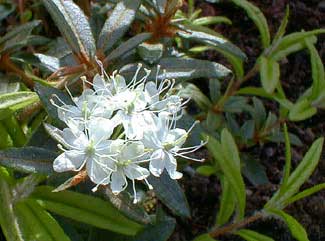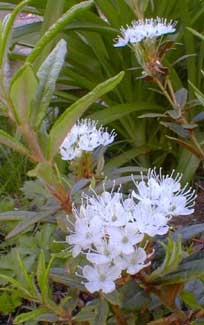
Tolmachev's
Rhododendron
"The spreading flowers are fair,
And everything is blythe & glad,
But I am fu' o' care.
Thou'll break my heart, thou bonie bird,
That sings upon the bough."
-Robert Burns
(1759-1796)
(1759-1796)
Rhododendron tolmachevii was not previously regarded as within the rhododendron genus, but was called Ledum macrophyllum, one of five shrubs of the genus Ledum, all of which have lost their standing as a separate genus.
The other four are now reclassified RR. groenlandicum, hypoleucum, tomentosum & neoglandulosum.
R. tolmachevii certainly is distinct enough that it is easy to understand how it would for a long while have been mistaken for something other than a Rhododendron.
The new species name for R. tolmachevii honors botanist A. I. Tolmachev, a leading figure in the Russian Botanical Society & a world authority on Arctic flora.
 The small white flowers are no bigger than on a chokeberry bush or a hawthorn tree, though with more dramatic stamins. The April photographs (2003 & 2004 respectively) show trusses of these little blossoms a bit larger than life-size.
The small white flowers are no bigger than on a chokeberry bush or a hawthorn tree, though with more dramatic stamins. The April photographs (2003 & 2004 respectively) show trusses of these little blossoms a bit larger than life-size. We obtained this young shrub from the Rhododendron Species Foundation. They grew it from seed started in 1999, the seed having been collected in Northeast Asia.
The dagger-slim evergreen foliage is amazingly fragrant, with a spicy musk reminiscent of herbal bath oil. It demands to be positioned close to a path edge so that passersby will be able to catch its scent at a brush.
Ours is positioned near a path at the foot of an old Western & Flame Azalea Hybrid, itself only barely fragrant while in bloom, but R. tolmachevii is fragrant year-round.
The essential oil from the scented leaves, still called Ledum camphor, has been used from this species & its near relatives in the manner of rosemary oil as a folk medicine for cough & inflammation, with the additional trait of causing inebriation.
Tolmachev's Rhododendron is native of Siberia, hence extremely cold hardy, to minus thirty Fahrenheit. It does enjoy full sun, but not a great deal of heat, & will suffer if it experiences droughty conditions.
Its ten year height is two to four feet, so it may be regarded as a dwarf or semi-dwarf, though over a greater period of time it can get quite large.